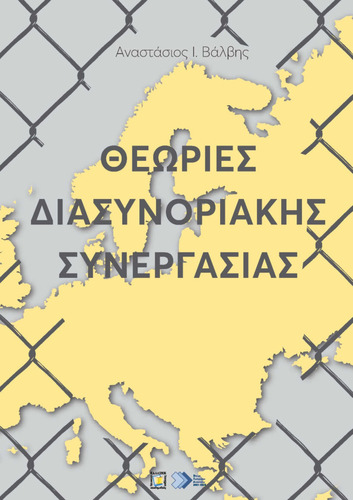| Title Details: | |
|
Cross-border cooperation theories |
|
| Authors: |
Valvis, Anastasios |
| Reviewer: |
Huliaras, Asterios |
| Subject: | LAW AND SOCIAL SCIENCES > POLITICAL SCIENCES > FOREIGN POLICY > FOREIGN POLICY > DEVELOPMENT POLICY LAW AND SOCIAL SCIENCES > POLITICAL SCIENCES > POLITICAL MEANS, POLITICAL INSTRUMENTS > INTEGRATION POLICY LAW AND SOCIAL SCIENCES > POLITICAL SCIENCES > FOREIGN POLICY > FOREIGN POLICY > EUROPEAN POLICY LAW AND SOCIAL SCIENCES > POLITICAL SCIENCES > FOREIGN POLICY > FOREIGN POLICY > EUROPEAN UNION (EU) FOREIGN POLICY |
| Keywords: |
Borders
Cooperation Cross-border Non-Governmental Organizations Integration Euroregion |
| Description: | |
| Abstract: |
This book aims to clarify the meaning of cross-border cooperation, focusing on the European model and examining the specific factors and processes that lead or, conversely, emerge as obstacles to the deepening of cross-border cooperation and cross-border integration. It begins by presenting the different interpretations attributed to borders, aiming to highlight their multilevel importance. It then focuses on the conceptual clarification of the terms of regional integration and regional governance, leading to the distinction between cross-border cooperation and cross-border integration. Subsequently, the interest shifts almost exclusively to the European context and the evolution of cross-border cooperation, emphasizing on the model of Euroregions, its evolution and the contribution of non-state actors to it. Further on, various examples, both with positive and not so positive results are presented showcasing in practice the great diversity that exists in cross-border cooperation models. The book endeavors to highlight, on the one hand the institutional evolution of euroregions, the motivations behind cooperation and the path towards integration (top-down or vice versa), and on the other hand the issues that can hardly be overcome in this effort. In conclusion, in the chapters of this handbook, a detailed analysis of theoretical approaches to cross-border cooperation takes place, in order for the reader to understand in depth the motives, obstacles, theoretical bases and European contribution to what is called "cross-border integration". At a second level, this book aims to evaluate the role of Civil Society in promoting and consolidating cross-border cooperation. Through various case studies, the obstacles and accelerators of cross-border cooperation become more understandable for the reader.
|
| Linguistic Editors: |
Polizois, Aggelos |
| Graphic Editors: |
Farmakis, Alkis |
| Type: |
Monograph |
| Creation Date: | 05-04-2024 |
| Item Details: | |
| ISBN |
978-618-228-168-0 |
| License: |
Attribution - NonCommercial - ShareAlike 4.0 International (CC BY-NC-SA 4.0) |
| DOI | http://dx.doi.org/10.57713/kallipos-401 |
| Handle | http://hdl.handle.net/11419/11820 |
| Bibliographic Reference: | Valvis, A. (2024). Cross-border cooperation theories [Monograph]. Kallipos, Open Academic Editions. https://dx.doi.org/10.57713/kallipos-401 |
| Language: |
Greek |
| Consists of: |
1. The meaning of “Borders” 2. Regional Integration and Regional Governance 3. Transboundary regions: From cooperation to integration 4. Regional cross-border cooperation in the EU: Euroregions and the theoretical approaches of European Integration 5. Third Sector’s contribution to cross-border cooperation 6. Case studies of cross-border initiatives 7. Conclusion |
| Number of pages |
232 |
| Publication Origin: |
Kallipos, Open Academic Editions |
| You can also view | |
| User comments | |
There are no published comments available! | |

